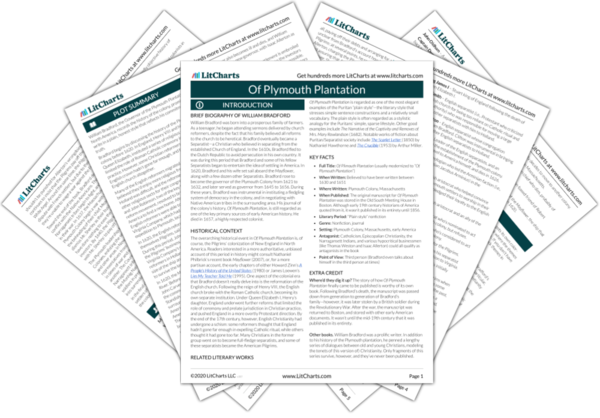Welcome to the LitCharts study guide on William Bradford's Of Plymouth Plantation. Created by the original team behind SparkNotes, LitCharts are the world's best literature guides.
Of Plymouth Plantation: Introduction
Of Plymouth Plantation: Plot Summary
Of Plymouth Plantation: Detailed Summary & Analysis
Of Plymouth Plantation: Themes
Of Plymouth Plantation: Quotes
Of Plymouth Plantation: Characters
Of Plymouth Plantation: Symbols
Of Plymouth Plantation: Literary Devices
Of Plymouth Plantation: Quizzes
Of Plymouth Plantation: Theme Wheel
Brief Biography of William Bradford

Historical Context of Of Plymouth Plantation
Other Books Related to Of Plymouth Plantation
- Full Title: Of Plimouth Plantation (usually modernized to “Of Plymouth Plantation”)
- When Written: Believed to have been written between 1630 and 1651
- Where Written: Plymouth Colony, Massachusetts
- When Published: The original manuscript for Of Plymouth Plantation was stored in the Old South Meeting House in Boston. Although early 19th century historians of America quoted from it, it wasn’t published in its entirety until 1856.
- Literary Period: “Plain style” nonfiction
- Genre: Nonfiction, journal
- Setting: Plymouth Colony, Massachusetts, early America
- Antagonist: Catholicism, Episcopalian Christianity, the Narragansett Indians, and various hypocritical businessmen (like Thomas Weston and Isaac Allerton) could all qualify as antagonists in the book
- Point of View: Third person (Bradford even talks about himself in the third person at times)
Extra Credit for Of Plymouth Plantation
Where’d they dig it up? The story of how Of Plymouth Plantation finally came to be published is worthy of its own book. Following Bradford’s death, the manuscript was passed down from generation to generation of Bradford’s family—however, it was later stolen by a British soldier during the Revolutionary War. After the war, the manuscript was returned to Boston, and stored with other early American documents. It wasn’t until the mid-19th century that it was published in its entirety.
Other books. William Bradford was a prolific writer. In addition to his history of the Plymouth plantation, he penned a lengthy series of dialogues between old and young Christians, modeling the tenets of (his version of) Christianity. Only fragments of this series survive, however, and they’ve never been published.












